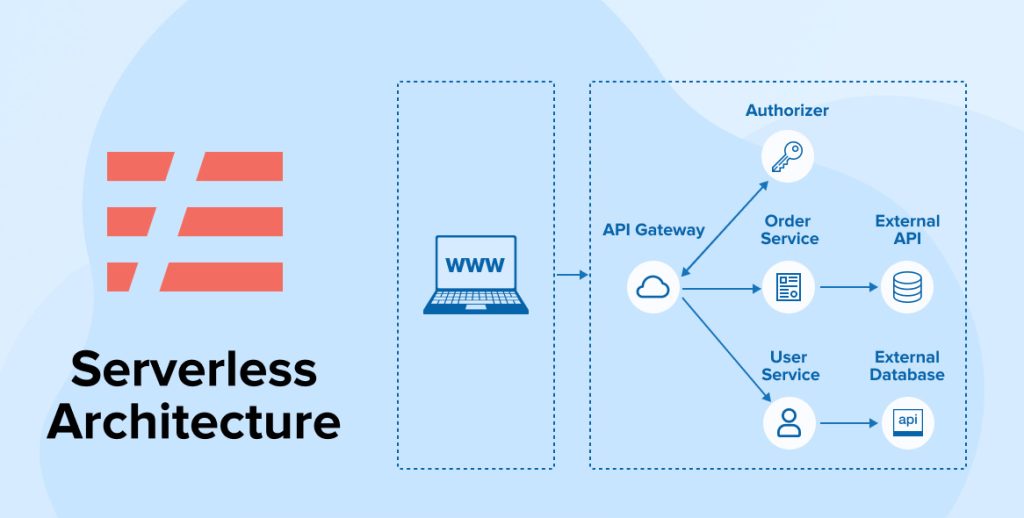Introduction
In the ever-evolving landscape of cloud computing, serverless architecture has emerged as a game-changer. It offers developers a way to build and scale applications without managing servers, provisioning infrastructure, or worrying about capacity planning. As businesses seek agility, cost-efficiency, and rapid deployment, serverless computing is becoming the go-to model for modern app development. Let’s see Serverless Architecture: Scaling Apps Efficiently in the Cloud.
This blog explores the fundamentals of serverless architecture, its benefits, use cases, challenges, and how it enables efficient scaling in the cloud.
What Is Serverless Architecture?
Despite the name, serverless doesn’t mean there are no servers. It means developers don’t manage servers. The cloud provider handles the infrastructure, scaling, and maintenance, allowing developers to focus solely on writing code.
Key Characteristics:
- Event-driven execution
- Automatic scaling
- Pay-as-you-go pricing
- Stateless functions
- Managed infrastructure
Popular serverless platforms include:
- AWS Lambda
- Azure Functions
- Google Cloud Functions
- Cloudflare Workers
- Netlify Functions
How Serverless Architecture Works
Serverless apps are typically composed of functions triggered by events. These events can be:
- HTTP requests
- File uploads
- Database changes
- Scheduled tasks
When an event occurs, the cloud provider spins up a container, executes the function, and shuts it down—all within milliseconds.
Benefits of Serverless Architecture
✅ Efficient Scaling
Serverless platforms automatically scale based on demand. Whether you have 10 users or 10 million, the infrastructure adjusts seamlessly.
✅ Cost Savings
You pay only for the compute time your code uses. No charges for idle servers.
✅ Faster Time to Market
Developers can deploy features quickly without worrying about infrastructure setup.
✅ Reduced Operational Overhead
No need to manage servers, patch operating systems, or configure load balancers.
✅ Improved Resilience
Serverless functions are stateless and distributed, reducing single points of failure.

Use Cases for Serverless Architecture
🛍️ E-Commerce
- Real-time inventory updates
- Payment processing
- Personalized recommendations
📱 Mobile & Web Apps
- Backend APIs
- Authentication flows
- Push notifications
🧠 AI & Machine Learning
- Data preprocessing
- Model inference
- Event-driven analytics
📧 Email & Messaging
- Transactional email triggers
- Chatbot responses
- SMS notifications
🗂️ File Processing
- Image resizing
- PDF generation
- Video transcoding
Serverless vs Traditional Architecture
| Feature | Serverless | Traditional |
|---|---|---|
| Infrastructure Management | None | Required |
| Scaling | Automatic | Manual or semi-automatic |
| Cost Model | Pay-per-use | Fixed or reserved |
| Deployment Speed | Fast | Slower |
| Maintenance | Minimal | High |
| Ideal For | Event-driven apps | Long-running processes |

Designing Serverless Applications
1. Break Down into Functions
Design your app as a collection of small, independent functions.
2. Use Event-Driven Architecture
Trigger functions based on user actions, database changes, or scheduled events.
3. Ensure Statelessness
Functions should not rely on local state. Use external storage like databases or object stores.
4. Optimize Cold Starts
Minimize function size and use warm-up strategies to reduce latency.
5. Monitor and Log
Use tools like AWS CloudWatch or Azure Monitor to track performance and errors.
Popular Serverless Frameworks
- Serverless Framework – Multi-cloud support, easy deployment
- AWS SAM (Serverless Application Model) – Native AWS integration
- Chalice (Python) – Lightweight AWS Lambda development
- Zappa (Python) – Deploy Flask/Django apps to Lambda
- Begin – Build full-stack apps with AWS Lambda
Challenges of Serverless Architecture
⚠️ Cold Starts
Functions may take time to initialize, especially in low-traffic scenarios.
⚠️ Vendor Lock-In
Switching providers can be difficult due to proprietary APIs and configurations.
⚠️ Debugging Complexity
Distributed functions make tracing errors harder.
⚠️ Limited Execution Time
Most platforms impose time limits (e.g., AWS Lambda: 15 minutes).
⚠️ State Management
Requires external services for session and state persistence.

Security in Serverless
🔐 Best Practices:
- Use least privilege IAM roles
- Validate all inputs
- Monitor for anomalies
- Encrypt data in transit and at rest
- Keep dependencies up to date
Real-World Examples
🧾 Netflix
Uses serverless for video encoding and real-time analytics.
🛒 Coca-Cola
Built a vending machine backend using AWS Lambda, reducing costs by 65%.
📦 Dropbox
Processes file uploads and metadata with serverless functions.
Future of Serverless Architecture
1. Serverless Containers
Combining the flexibility of containers with serverless scaling.
2. Edge Computing
Running serverless functions closer to users for lower latency.
3. AI-Driven Optimization
Using machine learning to optimize function performance and cost.
4. Multi-Cloud Serverless
Abstracting serverless across providers for portability and resilience.
Conclusion
Serverless architecture is revolutionizing how we build and scale applications in the cloud. By abstracting away infrastructure concerns, it empowers developers to focus on innovation and user experience. As the ecosystem matures, serverless will become the default choice for many workloads—offering unmatched scalability, efficiency, and agility.





